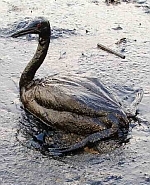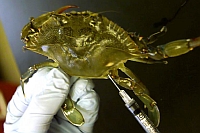Impact des hydrocarbures sur la flore et la faune marine (1/3) (en anglais)
Impact of Oil on Marine Flora and Fauna (1/3)
Besides the purely physical effect of oiling, flora and fauna can suffer from contact with oil through ecotoxicological and, in some cases, genotoxic phenomena.
Direct effects
The direct effects caused by oil vary from one taxonomic group to another and within the same taxonomic group, from one species to another. Furthermore, organisms in the first stages of their development may be more seriously harmed than adults. Within the same species, the eggs, larvae and juveniles are generally more sensitive than the adults. However, this tendency, which may seem perfectly normal to us, as we are often tempted to see the young as more fragile than adults, is not a hard and fast rule. The larvae of certain segmented worms are more resistant to hydrocarbons than the adults.
Aside from deaths caused by the effects of oiling, certain constituents of oil are incorporated in the water column, taken up by the biota, and can be toxic for marine plants and animals. This toxicity can be acute, causing the rapid death of organisms exposed to oil by contact or ingestion, or causing serious disturbance to their basic functions.
Delayed toxicity occurs when the organism's survival capacity is diminished, i.e. when there is a reduction in its growth rate, rate of reproduction, resistance to stress or to biological attack (illness, parasites, predators).
Acute toxicity is measured by the Lethal Dose 50 (LD50), the dose likely to kill 50% of the organisms to which it is administered over a given period. This expression of toxicity can be explained by the fact that all the members of a population do not have exactly the same sensitivity to any given toxic product. The LD50 measures the average sensitivity of a test population for a certain species.
Many laboratory-based studies have been carried out to determine the most toxic components of different oils. These are mainly aromatic compounds (polycyclic aromatic hydrocarbons or PAHs), which are fairly soluble and therefore quickly available for marine organisms. Agitation in the surrounding environment is a significant factor in the generation of concentrations of aromatic compounds. In conditions of mild turbulence, only the most soluble aromatic compounds enter the water mass. The others quickly evaporate before they have the chance to dissolve in the water. In strong turbulence, the least soluble volatile compounds also enter the water column.
Sublethal toxic effects
This loss of balance can take the form of
- reduced growth rates or fertility (alteration of gametes),
- increased mortality in larvae and juvenile stages,
- disturbed communication between individuals or between them and the environment, causing, for example, an alteration in their migratory behaviour,
- stunted growth, either through a loss of appetite or a reduction in their capability of transforming food into energy,
- various physiological or behavioural changes (these changes can generate a reduction in resistance to stress and the capacity to find or consume food), and
- late egg-laying and brooding.
In any one botanical or zoological group, the sublethal effects of oil spills differ considerably between taxonomic groups and from one species to another, in relation to the physiology and the behaviour of the organisms.
For example, in birds, a distinction can be made between
a. species that are highly vulnerable to oil spills, being completely dependant on the marine environment (e.g. puffins, common guillemots, cormorants), and
b. species with a high adaptation capacity, which are therefore mildly vulnerable (e.g. gulls, terns, albatrosses).


